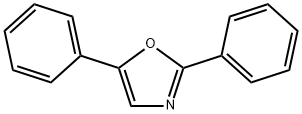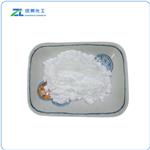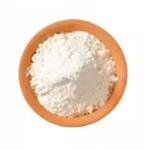Uses
PPO can be used as a dopant that improves the photo-electric feedback of plastic scintillators which are used as radiation detectors for nuclear materials. It can be coated on peptide substrates to facilitate radioactive labelling which can enable determination of substrate specificity of lysine methyltransferase enzymes. It may also be used in the fabrication of organic luminescent materials which can be used in light emitting diodes (LEDs).
General Description
2,5-Diphenyloxazole (PPO) is an oxazole that can be used as a scintillator and a laser dye. It has fluorescence at a wavelength of 375 nm. It can be used as a wavelength shifter in liquid samples due to their high quantum yield and large strokes shift.
Synthesis
The synthesis of 2,5-Diphenyloxazole is as follows:
In a 5000L enamel reactor with mechanical stirring and a thermometer, add benzoylaminoacetic acid (179 kg, 1 km) and thionyl chloride (238 kg, 2 km), react at 50°C, and monitor the sample until the compound is fully reacted. Unreacted thionyl chloride is distilled off to obtain benzoylaminoacetyl chloride. Cool down to 50°C, add benzene (780 kg, 10 kmol) to the reactor andAluminum trichloride (267 kg, 2 kmol), heated to reflux for 3 hours.The obtained N-benzoyl-ω-aminoacetophenone reaction solution was cooled to 30°C, 50 wt% sulfuric acid (392 kg, 2 kmol) was added, and the temperature was slowly raised to 100°C, and the reaction was completed at this temperature. Excess benzene was distilled off, the reaction solution was cooled to 30°C, water (1568 kg) was added dropwise to the reactor, and a white solid was precipitated, filtered, and rectified to obtain 2,5-diphenyloxazole of about 202 kg. The yield was 91.4%, the content was 99.3% (HPLC).






